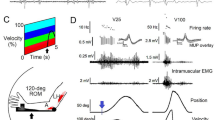Abstract
By means of intramuscular electromyographic recordings, we studied the firing frequencies and recruitment/decruitment thresholds of individual motor units in two elbow flexors, the biarticular biceps brachii muscle and the monoarticular brachioradialis muscle. Subjects had to perform isometric contractions with increasing elbow flexion torque until a specific peak torque level was reached. The torque level was kept constant for 6 s during which firing frequencies were measured. Then the torque was decreased to a lower level and, after 3 s, firing frequencies were again measured for 6 s. By repeating this procedure, the torque level was decreased stepwise until the motor unit under study stopped firing. The last level before the unit stopped firing was considered to be the decruitment torque level. We measured the firing frequency at recruitment and decruitment, the torque- frequency relationship and the recruitment and decruitment torque thresholds after various levels of peak torque. In the biceps, both the firing frequencies at a specific torque level and the decruitment torque level itself were independent of the peak torque. In the brachioradialis, however, firing frequencies at a specific torque level decreased and decruitment torque levels increased after subjects generated higher peak torques. Thus, in this muscle firing frequencies as well as decruitment thresholds show hysteresis effects. The result indicates a shift of force from the brachioradialis muscle during recruitment to the biceps muscle during decruitment. This shift is smaller than was concluded from previous studies in which decruitment threshold levels for the brachioradialis muscle were assumed to be independent of force history. Moreover, we found that in both muscles decruitment firing frequencies were lower than recruitment frequencies and they were independent of the peak torque level. In order to analyse the effect of the peak torque level on the distribution of force over the two muscles, we performed a model study in which we simulated the activation-frequency relation of two elbow flexors: a biceps-like and brachioradialis-like muscle, each contributing equally to the elbow torque during recruitment. In addition, we analysed how the different behaviour of the biceps and the brachioradialis during decruitment alters their contribution to the total torque production and how this redistribution is caused. The model study shows that the shift in contribution to the total torque is not constant during the relaxation phase and is not caused by a simple mechanism like a shift of activation from one muscle to another. Furthermore, changes limited to the muscle in which hysteresis is present do not seem to be sufficient to explain the experimental results.
Similar content being viewed by others
Author information
Authors and Affiliations
Additional information
Received: 19 October 1998 / Accepted: 14 June 1999
Rights and permissions
About this article
Cite this article
van Groeningen, C., Nijhof, E., Vermeule, F. et al. Relation between torque history, firing frequency, decruitment levels and force balance in two flexors of the elbow. Exp Brain Res 129, 592–604 (1999). https://doi.org/10.1007/s002210050929
Issue Date:
DOI: https://doi.org/10.1007/s002210050929




